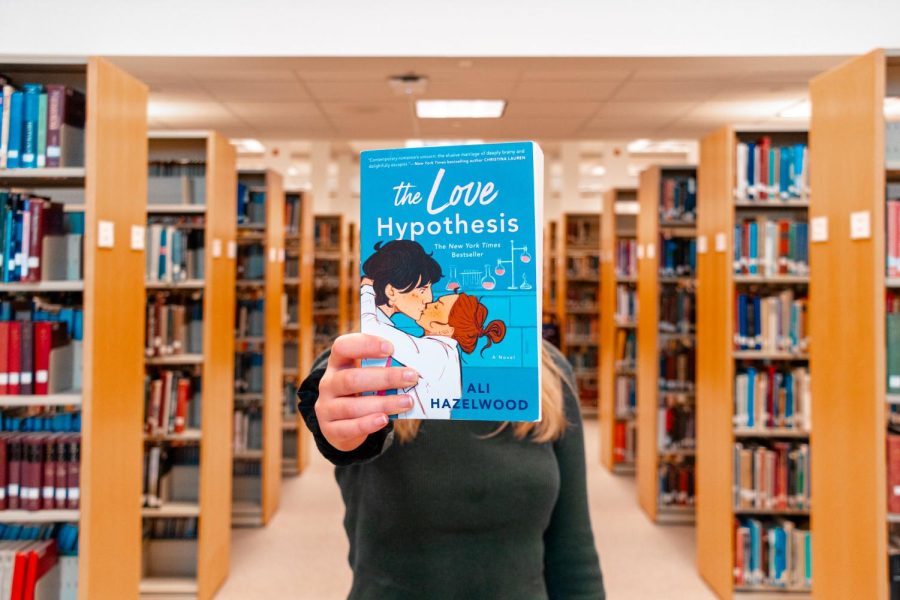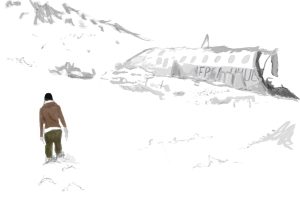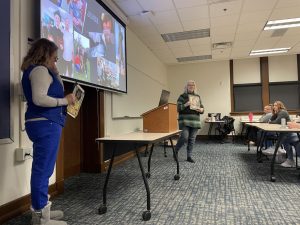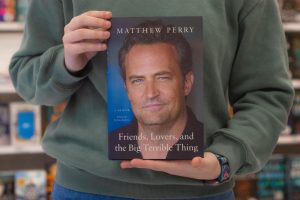Book in Review: “The Love Hypothesis”
“The Love Hypothesis” by Ali Hazelwood has gained much popularity on blogs and Book Tok, a genre of sorts on social media app TikTok focused on YA novels.
February 16, 2022
Isolation due to COVID-19 brought about an unprecedented era of loneliness, boredom, and ample free time for people all around the world. This was a culture shock, especially in the United States where capitalistic output is valued over personal enjoyment. People began to take up new hobbies ranging from baking to crocheting to thrifting, while others returned to hobbies from their childhood and teenage years such as video gaming, painting, and fanfiction reading.
While fanfiction gets a bad reputation for poor grammar, ridiculous plot, and borderline painful cliches, it provides an indulgent escape for bored or stressed minds. This is why books such as “The Love Hypothesis” by Ali Hazelwood have gained popularity on blogs and Book Tok, and after seeing so many raving reviews, I decided to give it a try. I was definitely skeptical going into it, remembering all too vividly the last popular fanfiction-turned-novel franchise, “Fifty Shades of Grey.” However, when I first saw the cover of “The Love Hypothesis” in Barnes and Noble and realized that the love interest is a dupe of Adam Driver, I was embarrassingly eager to shell out $10 for the paperback copy.
“The Love Hypothesis” is based on a “Reylo” fanfiction. For those who aren’t fluent in Wattpad and AO3 terms, “Reylo” is a fanfiction that centers on the dubiously romantic relationship between Star Wars characters Rey and Kylo Ren. For copyright purposes, Rey and Kylo Ren are respectively renamed Olive Smith and Adam Carlsen. The story is set in an alternate universe, taking place in a present-day university rather than the futuristic, galactic setting of the Star Wars franchise. The novel begins from the perspective of Olive, a postgraduate in Stanford University’s biology program who is working toward earning her Ph.D., fueled mainly by inordinate amounts of caffeine and her vaguely tragic backstory.
Olive’s best friend, Anh, feels guilty about developing mutual feelings for Olive’s ex-boyfriend, so in a convoluted plot to convince Anh that Olive has moved on, Olive kisses Adam Carlsen in front of Anh at a university event. To complicate things even further, Adam Carlsen is a biology professor at Stanford as well as an infamously cruel and despotic advisor. Things get even more complex and awkward as word spreads around campus about Olive and Adam’s kiss, so much so that Olive confronts Adam about it, at a loss for how to disperse the rumors about their supposed relationship.
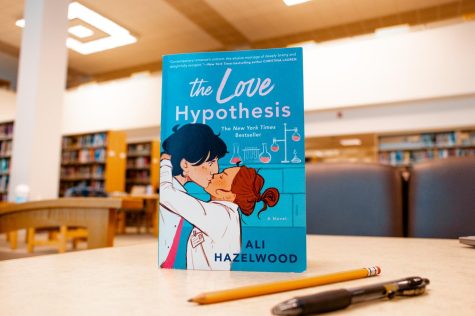
Adam is disturbingly unbothered by the rumors and instead proposes that they go along with it in a mutually beneficial agreement: Anh will believe that Olive has moved on with someone new and can finally get together with Olive’s ex, and Adam, who was deemed a flight-risk by Stanford, will have his research funds unfrozen once administration realizes he has set down roots at Stanford and has a reason to stay.
This agreement sparks all the standard fare of the fake-dating trope: rules and boundaries are set in place that will ultimately be broken one by one, and public dates are scheduled so all the nosey biology majors can see them together. As Olive works towards achieving her dream of synthesizing biomarkers that will detect early-stage pancreatic cancer, a series of tropes draw her ever closer to tall, dark, handsome, and broody Adam Carlsen, including but not limited to the miscommunication trope, forced cohabitation, tragic backstories, power imbalance, strangers to lovers, the sunshine one paired with the grumpy one, all tied together with an honorable mention of the one-bed trope.
In the interest of good and honest journalism, I have to admit that some sections were hard to get through. There were instances of cheesy dialogue, unexpected explicit scenes, and plot devices that made me smack the book against my forehead and question why I was putting myself through this. The power imbalance between Olive and Adam was never abused, but I feel that it’s harmful to represent such a relationship without discussing the ways in which it can go wrong because no one is as perfect as Adam in real life. The miscommunication trope, in my opinion, was frustrating rather than amusing and it was used to somehow drag out and complicate the plot even further. As much as I wanted to like and support Olive as a badass, woman-in-STEM character, I couldn’t get past the fact that a man still had to swoop in and help her solve all of her problems.
Despite all of its flaws, the saving grace of “The Love Hypothesis” was author Ali Hazelwood’s sense of humor and self-awareness. Several times, Olive made an offhand comment that came comically close to breaking the fourth wall, likening her situation to a poorly-written YA romance or a Hallmark movie. The irony made it a bearable and sometimes even an enjoyable read. If you’re craving a truly self-indulgent, escapist romance stuffed with all manner of tropes and sickeningly sweet fluff, you can just as easily find it for free on online fanfiction forums. However, if you want to appear intellectual and mysterious by reading a real paper novel, or if you want to imagine yourself kissing Adam Driver’s lookalike on the cover, I would recommend buying “The Love Hypothesis” at your own discretion.





























